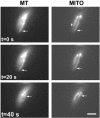Mitochondrial positioning in fission yeast is driven by association with dynamic microtubules and mitotic spindle poles
- PMID: 12972644
- PMCID: PMC208773
- DOI: 10.1073/pnas.1534703100
Mitochondrial positioning in fission yeast is driven by association with dynamic microtubules and mitotic spindle poles
Abstract
Microtubules mediate mitochondrial distribution in the yeast Schizosaccharomyces pombe and many higher eukaryotic cells. In higher eukaryotes, kinesin motor proteins have been shown to transport mitochondria along microtubules, but the nature of the mitochondria-microtubule interactions in S. pombe has not been explored. By time lapse, total internal reflection fluorescence microscopy, or spinning-disk confocal microscopy, mitochondria appeared to be both tethered to ends and bound laterally along the sides of microtubules. Mitochondrial tubules extended and retracted when attached to the tips of elongating or shortening microtubules, respectively, but translocation along established microtubules was never observed. Mitochondria that were not associated with microtubules were largely immobile until they were "captured" by a growing microtubule. In mitotic cells, a portion of the mitochondria was tethered to the spindle-pole bodies and moved to the cellular ends during spindle elongation. This association may be important for organelle inheritance during cell division. Thus, in contrast to kinesin-mediated transport used by higher eukaryotes, mitochondrial motility and distribution in fission yeast are driven largely by microtubule polymerization and the elongation of the mitotic spindle.
Figures




Similar articles
-
Positioning and elongation of the fission yeast spindle by microtubule-based pushing.Curr Biol. 2004 Jul 13;14(13):1181-6. doi: 10.1016/j.cub.2004.06.029. Curr Biol. 2004. PMID: 15242615
-
Imaging individual spindle microtubule dynamics in fission yeast.Methods Cell Biol. 2013;115:385-94. doi: 10.1016/B978-0-12-407757-7.00024-4. Methods Cell Biol. 2013. PMID: 23973085
-
The dynamin related protein Dnm1 fragments mitochondria in a microtubule-dependent manner during the fission yeast cell cycle.Cell Motil Cytoskeleton. 2009 Aug;66(8):509-23. doi: 10.1002/cm.20351. Cell Motil Cytoskeleton. 2009. PMID: 19373772
-
Microtubule-dependent spatial organization of mitochondria in fission yeast.Methods Cell Biol. 2010;97:203-21. doi: 10.1016/S0091-679X(10)97012-X. Methods Cell Biol. 2010. PMID: 20719273 Review.
-
The fission yeast spindle orientation checkpoint: a model that generates tension?Yeast. 2006 Oct 15;23(13):1015-29. doi: 10.1002/yea.1410. Yeast. 2006. PMID: 17072894 Review.
Cited by
-
Axonal transport of mitochondria requires milton to recruit kinesin heavy chain and is light chain independent.J Cell Biol. 2006 May 22;173(4):545-57. doi: 10.1083/jcb.200601067. J Cell Biol. 2006. PMID: 16717129 Free PMC article.
-
Moving mitochondria: establishing distribution of an essential organelle.Traffic. 2007 Dec;8(12):1668-1675. doi: 10.1111/j.1600-0854.2007.00644.x. Epub 2007 Oct 17. Traffic. 2007. PMID: 17944806 Free PMC article. Review.
-
Simple to Complex: The Role of Actin and Microtubules in Mitochondrial Dynamics in Amoeba, Yeast, and Mammalian Cells.Int J Mol Sci. 2022 Aug 20;23(16):9402. doi: 10.3390/ijms23169402. Int J Mol Sci. 2022. PMID: 36012665 Free PMC article. Review.
-
Reversible solidification of fission yeast cytoplasm after prolonged nutrient starvation.J Cell Sci. 2019 Nov 8;132(21):jcs231688. doi: 10.1242/jcs.231688. J Cell Sci. 2019. PMID: 31558680 Free PMC article.
-
Genome-wide identification and characterization of the CLASP_N gene family in upland cotton (Gossypium hirsutum L.).PeerJ. 2022 Jan 3;10:e12733. doi: 10.7717/peerj.12733. eCollection 2022. PeerJ. 2022. PMID: 35036102 Free PMC article.
References
-
- Yaffe, M. P. (1999) Science 283, 1493–1497. - PubMed
-
- Vale, R. D. (1987) Annu. Rev. Cell Biol. 3, 347–378. - PubMed
-
- Nangaku, M., Sato-Yoshitake, R., Okada, Y., Noda, Y., Takemura, R., Yamazaki, H. & Hirokawa, N. (1994) Cell 79, 1209–1220. - PubMed
-
- Kanbe, T., Kobayashi, I. & Tanaka, K. (1989) J. Cell Sci. 94, 647–656. - PubMed
Publication types
MeSH terms
Substances
Grants and funding
LinkOut - more resources
Full Text Sources

